MY TEENAGED KIDS ARE WELL PAST THE AGE when everything they do is internet-adorable—born too early for full social media overexposure!—but especially in the summer, they’re with me a lot of the time as I roam the food scene, occasionally making cameo appearances at the edges of my stories. And a few months ago they tagged along to the Chicago Jewish Film Festival to see the film about their, and everyone’s, favorite Jewish grandmother, Ina Pinkney. We sat down and then I realized that right behind us were chef Thai Dang and his wife Danielle. I don’t know exactly how they know Ina—except, of course, that everyone knows Ina. But if either of my kids goes on to a brilliant career in the restaurant industry, I’ll know exactly where we were when they first made the contact that launched it.
The Dangs, of course, went from a messy departure from Embeya, the West Loop Vietnamese-flavored upscale restaurant which recently closed, to announcing plans for a somewhat homier place called HaiSous. I attended a preview for it over a year ago, and went home with an invitation to the opening as soon as it was announced. But chef proposes and the real estate market disposes—and by this summer, the long-delayed restaurant had found an entirely different future location in Pilsen. The hope is to finally open this fall—October?—and this time they feel it’s close enough to begin doing pop-up dinners, to get the staff some familiarity and practice with what HaiSous will offer.
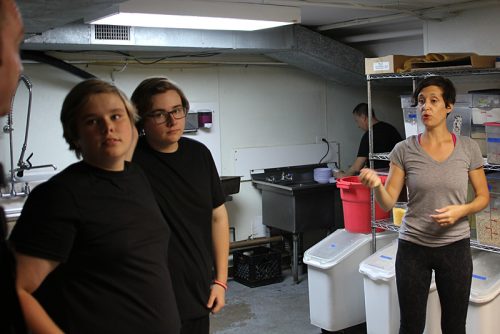
Liam, 14, and Myles, 17, about to get assignments from Danielle Dang
Which is where my kids move closer to center stage in this story. Danielle contacted me with an idea: how would we like to work one of the pop-ups as a family? I’d cover it, the kids would work, and we’d all get to try the food. I liked the first and third of those ideas just fine, but I loved the idea of my kids getting some exposure to the world of work. So we bought Dad a black T-shirt (I settled on my T-shirt-free personal style somewhere during the Reagan years, I think) and arrived at 3:30 at White Oak Tavern in Lincoln Park in contemporary restaurant gear, ready to be the lowest, least competent members of the team.
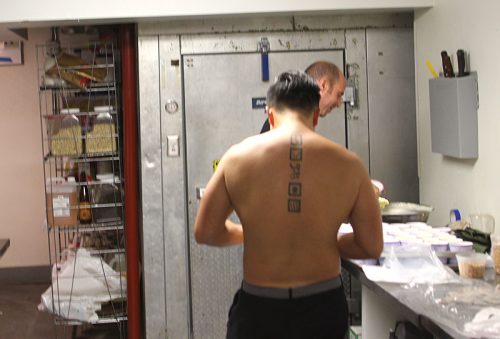
Chef Thai’s pictogram tattoos—the center being the logo for El Bulli
MYLES WENT STRAIGHT TO WASHING DISHES with Juan in the basement, while Liam was put on carrying the clean dishes upstairs and stacking them on the pass between the kitchen and the dining room. The Dangs had arrived at White Oak Tavern with a full set of Asian-themed china—or rather, plastic dish ware. They come out of fine dining—Thai’s most prominent experience before Embeya was at L2O under Laurent Gras and at the Elysian Hotel’s RIA, both Michelin-starred in their day—and Embeya had aimed to deliver Vietnamese flavors on an upscale level far above any previous Vietnamese restaurant in town. As I said in the Reader last year, though, it did so at a moment when “the fine-dining crowd had come to accept much more casual settings for refined Asian food made with fine-dining techniques (Yusho, Fat Rice, Parachute).”
HaiSous intended to be closer to that kind of casual Asian restaurant, partly out of necessity—the money that had gone into Embeya wasn’t around this time—but also because they genuinely seemed to want to do less dressed-to-impress, more authentic Vietnamese food. Or in other words, to bring on the funk that had been a bit hard to find at Embeya. As if to prove the point, as we went downstairs Thai was rendering duck cracklings, hunks of fatty duck skin. I said to Danielle, “It’s Lincoln Park upstairs, but it smells like Argyle downstairs.”
On the other hand, once he was done with the splattery cracklings, Thai changed into his chef’s whites—revealing a back tattoo which he explained to me. It consists of five pictograms, and the center one is the logo of one of the most aspirational restaurants in the world—El Bulli in Spain—together with symbols representing the building blocks of cuisine (such as a hook to signify fish). HaiSous, it seems clear, still is going to straddle the worlds Thai Dang comes from—the simplicity of homey Vietnamese food (Embeya, famously, was named for his own childhood nickname) but the intense devotion to precision technique you had to have to work at the level of L20—or El Bulli.
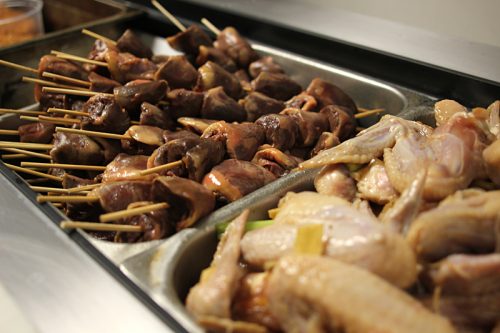
Duck heart skewers and duck wings
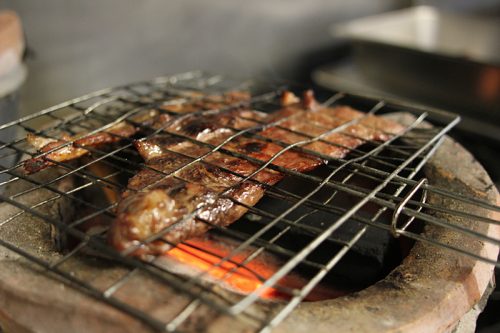
Grilling on traditional Vietnamese clay pots
I followed Thai into the kitchen, surprised to see that the cooking seemed to be relatively modest—I guess I was expecting great heaps of food on roaring grills and in bubbling pots, but instead what seemed to have taken over the kitchen were four traditional Vietnamese clay pot grills with glowing coals inside (to judge by the smokeless fire, something like the bincho used in Japanese izakayas). The meat is placed between thin wire grates and cooked directly over the fire, tended so it rises to sizzling temperatures but doesn’t burn; Thai showed me sticks of lemongrass which are used to brush oil on the meat, and fanned the flames through a vent in the bottom with a piec of cardboard.
“It’s influenced by the Chinese and the idea of feng shui,” Thai said. “Hot and cold, they believe that when you eat poultry, you have to eat some herbs to balance it.”
Thai and his crew were preparing samples of the dishes for the staff to taste before service. It was probably not strictly necessary that everyone understood the menu—almost everything was being served family style tonight, so there wouldn’t be a lot of explaining it to the diners—but if you’ve been trying to open a restaurant for over a year, you’re probably eager to have anyone taste your food. In that sense, I was impressed that Thai seemed so calm and together; it was a big night for him, the closest he’d gotten to his restaurant being open.
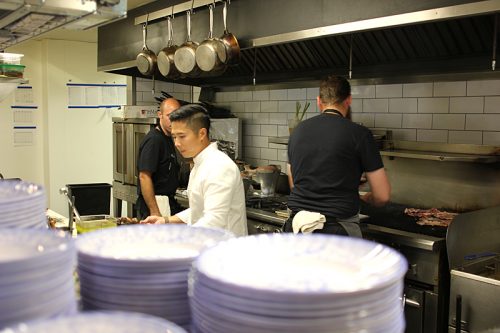
The kitchen, behind the dishes Liam stacked on the pass.
He and the other cooks started setting out dishes on the pass. The front of house staff took care of other pre-shift duties, like folding menus and napkins. Liam and I had to puzzle how to assemble a sign without asking Thai, who Danielle said was the only one who knew how to put it together. Happily, we figured it out without breaking it. It was almost 5:00.
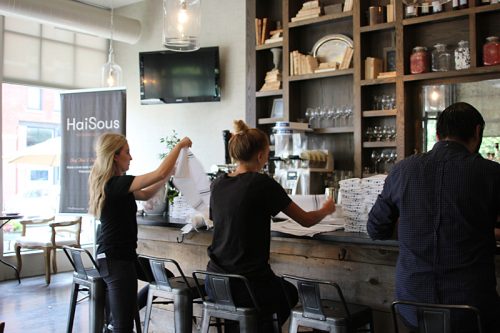
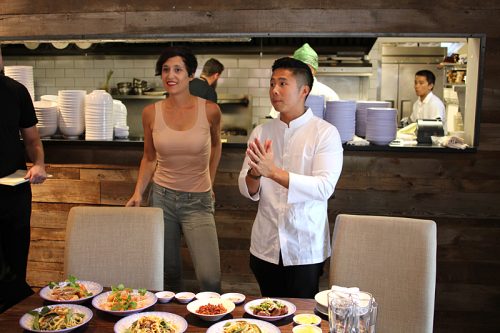
“DON’T BE SHY, EVERYBODY COME ON IN,” Thai said. The first set of courses was laid out on the table in front of him. He thanked everyone for showing up to work the dinner, then said, “This is Vietnamese style, right here. This is everything that is quintessential about Vietnamese—texture, the nuance of Vietnamese flavor. We like texture in all aspects of our food. Seasoning, too—saltiness, sweet, sour, spicy. It’s always there. We always focus on these elements.”
“For me,” he said, “I wanted to create Vietnamese dishes, not like Vietnamese folk—because you could go have it up on Argyle. But that’s the fun part of being a chef—taking that skill level and refining it, doing what we can to elevate it. That’s our goal for HaiSous.”
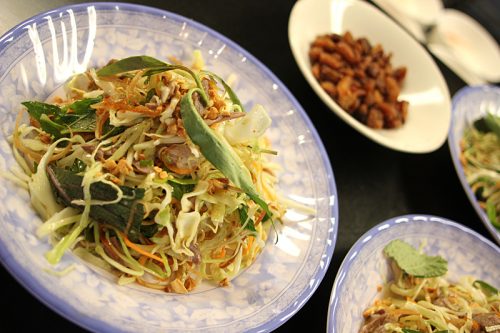
He pointed to the first things set out to try—Goi Vit, duck salad, and the duck cracklins. “Goi is literally salad, but there are hundreds of variations. What we did is, we take duck leg, and poach it in a liquid of lemongrass, ginger, chile, and mix it into the salad, which has banana blossom, cabbage, and then it always has Vietnamese coriander—I purposely left the leaf on top so you could see it. Without this herb, Vietnamese don’t consider it goi vit. It’s influenced by the Chinese and the idea of feng shui—hot and cold, they believe that when you eat poultry, you have to eat some herbs to balance it.”
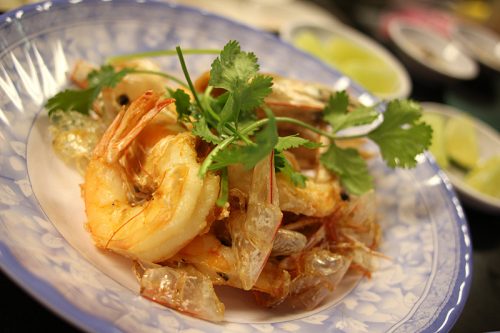
Next he showed us fried shrimp—heads on but the shell removed from the sides, so you got the effect of how Asian shrimp are served, but didn’t have to pick them apart yourself. (If you like the fried shells, they were in there too.) “This is Tom Chien Muoi Ot, fried shrimp. What makes it special is this thing,” he said, holding up a small dish containing seasonings. “Salt, pepper, chile, just three elements. And then you squeeze a lime into it to make this sauce—” he did just that, making a slurry in the dish.
“And that’s usually how I introduce it when I drop it to the table,” Danielle said. “I say, this is our Vietnamese dipping sauce, you’re going to make this yourself by introducing a little lime juice.”
“I love to eat the head,” Thai said. “Dip the head and eat the whole thing. But the shrimp is already deveined, so if the guests don’t want to eat the head, it’s up to them.”
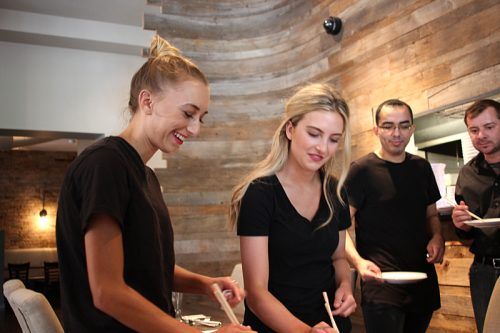
He walked through some other dishes—duck heart skewers (an add-on to the $50 ticket price) and duck wings. The front of house staff gave each of them a try—I’m not going to swear everyone tried a duck heart, though Myles did—and then the main dish was brought out: a bowl of salad and rice noodles, and plates of the pork that was grilled over the clay pot grills.
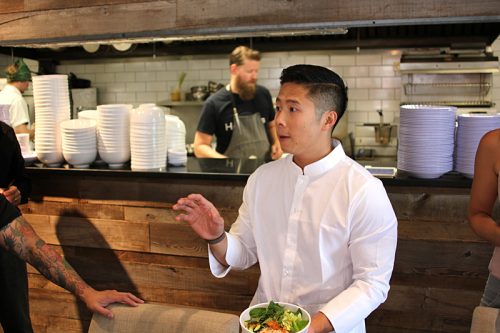
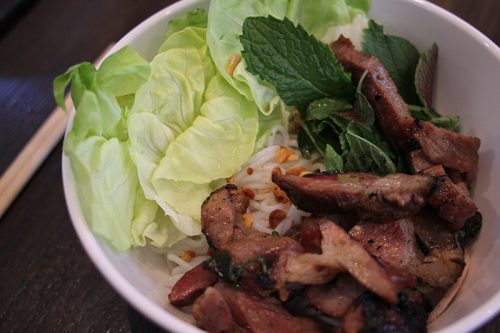
At that preview the year before, Thai had served Bun Cha Hanoi, noodles and grilled meat in broth. Tonight it would be Bun Thit Nuong. “This is Southern style—the preparation is cold, and then you get grilled meats along with it,” Thai said. “The best way is to let the guests know that it’s all been dressed, and then they just grab the meat, and mix it in with the stuff in their bowl.”
Thai ran through a last couple of items including two simple desserts—rice pudding with peanuts, and a coconut milk dessert filled with grilled pineapple and other fruits. The team dug into and tried the different items, loosening up a bit. As Danielle worked with the bar staff, Steve Fladung, an old friend from L2O and RIA days who’s helping run the popups (and also helping create the wine list), gave the front of house staff a talk to get them set up to succeed tonight. We’d heard from the commanding officer, now here was the sergeant.
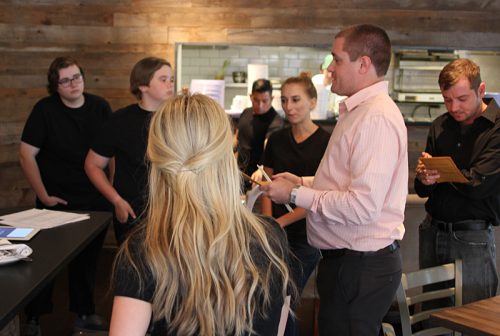
“If you have any questions or issues, come to me,” Fladung said. “We want Danielle to be able to spend time with the guests, to welcome them, to be happy on the floor. If there’s a problem, bring it to me.” I noticed that Myles was a little worried-looking; I reassured him that he didn’t have to take orders or know that Gruner Veltliner is “the perfect match for everything Chef cooks,” another thing that Fladung said a moment later. But it didn’t bother me for him to get a little exposure to that level of adult responsibility for other peoples’ night out, either.
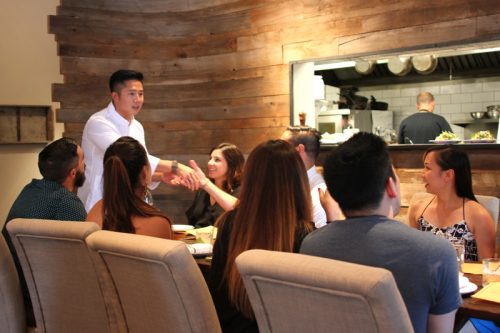
IN FACT, THOUGH, WE GOT A PRIVILEGE that the people doing the real work didn’t—we were invited to sit down to dinner at 5:30 and be guests, not staff. Vietnamese was the first Asian food my kids were exposed to; they’d slurp noodles out of pho and eat grilled beef when they wouldn’t touch pot stickers, and that night, they dug into it heartily (I believe the exact phrase was “Why didn’t I eat more of the free pork when it was just sitting there?”)
Also at that first seating was Ina Pinkney, and after the meal we compared notes. “It’s so fresh tasting,” she said, and I agreed. “Why doesn’t everybody put mint in salad?” Well, and grilled pork for that matter. But to make it work you have to know how to balance and counterpoint all the flavors, and that’s what Chef Dang is so good at. I kind of hate the word “elevated” when applied to upscale versions of traditional foods—I find too often the price is elevated and the food is merely enervated—but it fit here: this was the instantly accessible freshness of Vietnamese cuisine, but with fine dining care and precision in every bite.
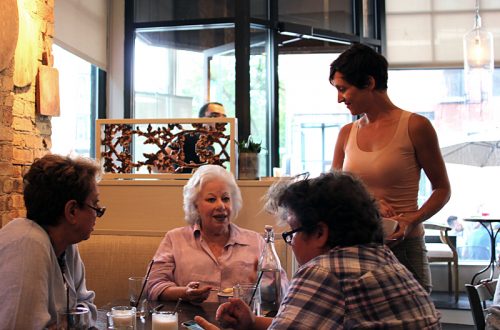
Ina and friends
A few days later, I checked in with Danielle to see how she thought the first night went. One thing she mentioned was that a lot of the staff has been with them before—all the kitchen staff came from Embeya, and some of the front of house went back as far as RIA. (It’s almost like working with your family!) “But we also had newcomers, and one of the great things about doing a dinner is that it’s a great exercise in pulling the team together,” she said. “Because you never know what’s going to happen until you do it, and once you get into that hustle, there’s a deep bond by the end of the night.”
I asked her what she saw that needed work. “Well, Thai’s having a meeting with his staff to talk over what worked and what needs some adjustment in the kitchen,” she said. “For me, we know we need to tighten up the floor plan, so there’s a clear order of who’s responsible. Part of the point of doing this is just finding what position everybody is good at. As an owner, you want to have the kind of place that creates a platform that allows the professionals in this business to shine.”
As we were leaving, I asked my kids what they thought about their first formal experience with work. Liam is 14 and he’s still a kid, so he was glad to do it and get paid, but just as glad to be done for the night. When I was 14 I worked at Mr. Dunderbak’s in the mall, and time never moved so slowly in my life as on those shifts.
But Myles, 17, was another matter. “I liked cleaning the dishes. I found it kind of meditative,” he said. When Danielle asked him if he’d like to help out on the rest of the dinners, running plates and doing other things, he was genuinely excited—and believe me, so was I.
HaiSous will host pop-ups every Sunday this month at White Oak Tavern, and possibly ongoing until the opening. To get tickets and find out about upcoming dinners, go here.
Disclosure: my children were paid for their work, and Myles will be paid for future shifts. I got dinner.
Correction: a Vietnamese dish name has been corrected.
Michael Gebert is editor and upstairs-dish-carrier of Fooditor.
Latest
Join the Discussion
After you comment, click Post. If you're not already logged in you will be asked to log in or register with Disqus.







